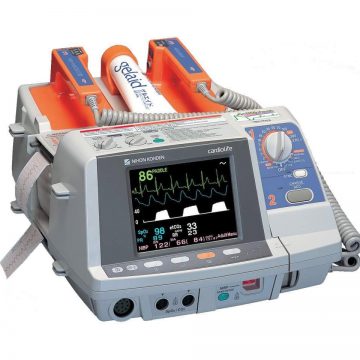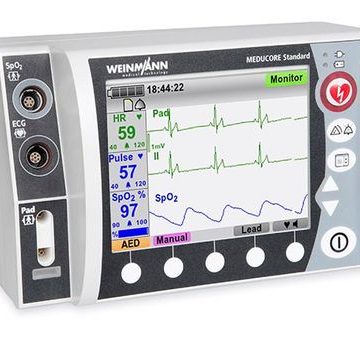Biphasic Defibrillation Waveform
TEC-5500K series provides low energy biphasic waveform defibrillation. Biphasic waveform defibrillation requires lower energy than conventional monophasic defibrillation and causes less damage to myocardium. Biphasic technology demonstrates superior results to save the patient from cardiac arrest.
Nihon Kohden’s unique ActiBiphasic technology* provides an improvement over most conventional biphasic circuits by employing an original T-circuit. In conventional biphasic circuits, when contact imped ance is high, pulse width becomes wider which reduces the efficiency of defibrillation. Nihon Kohden’s T-circuit actively controls the shape of the second phase waveform to maintain constant pulse width.
*Patent pending
Fast Charging
Charging from 0 to 200 J takes less than 3 seconds and charging from 0 to 270 J takes less than 5 seconds in both AC and DC operation. (with a fully charged new battery at 20°C)
Quick ECG Waveform Recovery
After defibrillation, the ECG waveform recovers within 3 seconds so you can immediately check the result of defibrillation.
AED (Automated External Defibrillation)
AED is available with an optional disposable pad adapter cable and disposable pads. When shockable rhythm is detected, the defibrillator automatically starts charging for hands-free defibrillation.
Color TFT LCD
2 waveforms can be displayed simultaneously on a crisp TFT color LCD screen.
Defibrilator
Model: Tec-5531K
Manufacturer: Nihon Kohden
Origin: Japan
Specification:
Defibrillation type: Manual, Synchronized, AED*
*with optional disposable pad adapter cable
Output energy (across 50 ΩΩΩΩΩ ): 2, 3, 5, 7, 10, 15, 20, 30, 50, 70, 100, 150, 200, and 270 J
Energy accuracy:
2J: ±0.5J
3J: ±1J
5 to 15J: ±2J
20 to 270J: ±10%
Energy limit: 50J for the internal paddles
Output waveform: Biphasic, truncated exponential constant power
Charging time:
Powered by AC 100 V to 240 V: maximum 5 s to 270 J, maximum 3 s to 200 J
Powered by a fully charged new battery at 20°C ambient temperature: maximum 5 s to 270 J, maximum 3 sto 200 J
Charging display: Displays the charged energy value on the screen
Charge status indication: A charged status sound is emitted after charging is complete.
Synchronized discharge: Available
Discharge time:
From the peak of R wave to the peak of discharge:
With lead ECG or paddle ECG: within 60 ms
Maximum continuous charge/discharge cycles at 270 J:
20 cycles: 3 cycles per minute with 1 minute cool down period after every 1 minute charge/discharge period
15 cycles: 3 cycles per minute with no cool down period
Discharge test: Available
Automatic internal discharge: Stored energy is internally discharged in the following cases:
1) Energy selector is set to DISARM
2) Power is turned OFF
3) Paddle connector is disconnected from the main unit
4) Preset period passed after completion of charging
5) Disposable pads are removed from the patient
Paddle electrode size:
For adults: 70 × 106 mm (±3 mm)
For children: 45 × 53 mm (±3 mm)
Paddle cord length: 2.0 m or more (when pulled by
18N force)
Paddle contact impedance:
Indicated by three LEDs on the sternum paddle
Green: 0 to 100 Ω
Yellow: 100 to 200 Ω
Orange: > 200 Ω
Monitor
Display: 5.7 inch, color LCD
Resolution: 320 (H) × 240 (V)
Effective display area: 117 × 88 mm
Number of traces: 1 (ECG), or 2 (ECG cascade, Pulse *, CO2*)
* with optional DSI unit
Sweep length: 97 mm
Sweep speed: 25 or 50 mm/s (ECG, pulse*), 6.25 or 12.5 mm/s (CO2)*with optional DSI unit
Amplitude limit: 40 mm
Baseline position: Fixed
Alphanumeric display: Heart rate, SpO2 (%) * , Pulse rate * , EtCO2 * ,Respiration * * with optional DSI unit
Other display indications: SYNC, CHARGING,
CHARGED, FIXED MODE, DEMAND MODE, ~ (AC
operation), battery mark (indicates remaining operation
time), messages, SC card mark, recorder mark
ECG lead: Paddle, I, II, III, aVR *1 , aVL *1 , aVF *1 , V (one
of V1 to V6) *1 , AUX, TEST *2
*1: with 5-electrode connection cable
*2: with TEST load ON at the system setup
Alarm setting:
Heart rate/pulse rate limits (5 bpm/step)
High: 20 to 300 bpm, off
Low: 15 to 295 bpm, off
SpO2
limits (1% step)
High: 51 to 100%, off
Low: 50 to 99%, off
Pulse rate limits (5 bpm/step)
High: 20 to 300 bpm, off
Low: 15 to 295 bpm, off
EtCO2
limits: (1 mmHg/step)
High: 2 to 99 mmHg, off
Low: 1 to 98 mmHg, off
Respiration rate limits (2 resp/step)
High: 2 to 150 respiration, off
Low: 0 to 148 respiration, off
Apnea (5/step)
High: 5 to 40, off
Low: 0 to 35, off
ECG Amplifier
Sensitivity: × 1/4, 1/2, 1, 2, 4, auto gain
Frequency response:
Through ECG electrodes: 0.05 to 150 Hz (-3dB)
Through paddles: 0.5 to 20 Hz (-3dB)
AUX: 0.05 to 150 Hz (-3dB)
Baseline recovery time: Less than 3 s after defibrilla-
tion at 270J
Input impedance:
Through ECG electrode: 5 M Ω or more (at 10 Hz 1mV)
Through paddles: 100 k Ω or more
Aux: 100 k Ω ± 10%
CMRR: 100dB or more (against chassis ground) when
AC filter is ON
AC filter: Provided (common with 50/60 Hz), ON at
–20 dB or less, OFF
Pacing pulse rejection: ON/OFF
External ECG input sensitivity: 10 mm/1V ±5%
(sensitivity × 1)
Heart rate count range: 15 to 300 bpm in defibrilla-
tion and monitor mode, 15 to 220 bpm in pacing mode

